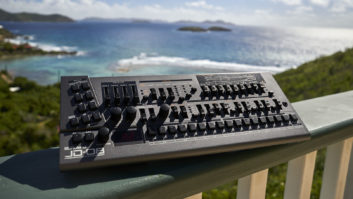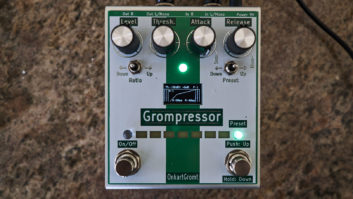
Equalizers, arguably the most important tools in our kit, are abundantly available on the market in hardware form and in digital plug-in form, sometimes aided by artificial intelligence, sometimes meticulously modeled after analog classics. Considering all that, one has to ask why Maat would bother creating yet another parametric stereo equalizer plug-in. The answer is simple: Maat sought to create the best one to date … and may very well have succeeded.
Unlike Maat’s thEQorange (designed to be an improvement on Algorithmix’s linear-phase Orange EQ), or Maat’s thEQred (designed to be an improvement on Algorithmix’s linear-phase Red EQ), thEQblue 12 is a minimal-phase EQ meant to offer musicality and pleasant coloration, and to achieve such euphonics with a staggering 12 different curve types, all reverse-engineered from analog EQs. This much flexibility requires a sophisticated GUI and forward-thinking controls, allowing extremely detailed frequency control for mastering engineers and those few engineers who need “next level” control beyond that available via traditional hardware or plug-ins.
Blue is available in AAX, AU, VST2 and VST3 formats. A dongle is no longer necessary, as Maat now offers cloud licensing with online or offline licenses.
Out of the Box
Via thEQblue 12’s GUI are 12 bands of control, including 1st and 2nd order highpass and lowpass filters, bell curves and shelving filter variants (both 1st and 2nd order). High- and lowpass filters are stackable to create extreme slopes. These 12 filters can be applied to any of the 12 bands and the filters can be chosen (globally) to be one of 12 varieties as follows:
• Classic Sym – Almost Const-Q bell curves
• Classic Asym – Boosts like Classic, but narrower cuts
• Proportional 1 – More “musical” than Const-Q, wider slopes at <6 dB, narrower at >6 dB
• Proportional 2 – Like Proportional 1, but greater width at >6 dB gain, good for vocals
• Proportional 3 – Like Proportional 1, but wider slopes at <3 dB gain
• Const-Q Asym – Boosts like Classic, cuts like Proportional 3, found on many American consoles
• Const-Q Asy R – Like Const-Q Asym, but with equal boosts and cuts
• Const-Q Invers – Similar to Const-Q Asy R (differences unknown to this writer)
• Const-Q Ideal – Like Classic Sym, but frequency, gain and Q are independent, not found in analog
• Const-Q New – Series proportional Const-Q, unique to Maat (in ways unknown)
• Parallel FF-FB – Parallel feed forward/feedback, as found in high-end graphic EQs, ideal for mastering
• Parallel LC Asy – Tonal properties and band interaction as found in passive EQs (a la Manley’s Massive Passive)
To be specific, these are high-resolution emulations of analog equalizers, but are not models, so no noise, distortion or other nonlinearities are carried over; you get just the pure filter behavior. Switchable oversampling is provided for lower sample rates like 44.1 and 48k, but sample rates up to 384k are supported, with center frequencies up to 80k to allow ultrasonic adjustments. Internal processing is at 80-bit, ensuring very low noise and distortion.
In order to make comparisons somewhat user-friendly, there are switchable A and B memory banks and the ability to globally step through the 12 filter topologies. When using bell filters at settings of +6 dB and a Q of 0.71, all 12 topologies have the same filter shape; it is only when applying more or less gain, or overlapping filters that the different topologies create sonic differences.
Adjustments can be made numerically on each band, or by grabbing nodes directly on the graph. Adjustments can be made in stereo, left channel only, right only, in mono, or the L to R difference. Bands can be grouped, for adjusting frequency, Q or gain to multiple bands at once. A Keyboard mode allows tuning a frequency by ear and then locking them to a section with a click. There is a three-section level meter (green, yellow, red), and true peak metering alerts you of (digital) overs.
In the Mix
thEQblue 12 is obviously very deep, versatile and flexible, and I’d be exaggerating to say that I managed to try every possible mode or function across all the many variables. As I applied thEQblue 12 to my tracks, subgroups and mixes (via mastering), one dominant trait became clear: thEQblue 12 is extremely clean with minimal phase shift, no apparent noise and an absence of distortion. When you grab a node and change gain, all you hear is the gain change—no side effects, no secondary problems created. Compared to stock DAW EQ, the difference is profound; you’ll likely find yourself hitting bypass just to be sure you actually made a change.
The GUI handles the herculean task of enabling a world of functions quite well, simplifying a multitude of curve choices as much as could be expected. Within that multitude of choices lies the only real problem with using thEQblue 12: Who has time to audition all the variables, whether a client is waiting on you or not? For that matter, my well-trained ear had difficulty identifying the minute differences between the many curve-shaping varieties—differences that only golden-eared mastering veterans in ideal rooms could clearly differentiate (much less find preferences among).
I will say this much, however: Classic Symmetrical curves work quite well for typical EQ jobs, but Classic Asymmetrical does indeed work better for narrow surgical cuts, like removing resonances. The Proportional curves work nicely for achieving shallow wide boosts, like one might use on whole mixes. The Parallel modes do indeed have a unique sound that is more band-interactive and “colorful.” Finally, the Constant Q curves are useful when more significant work is needed, such as high-amplitude boosts.
With more flexibility than any one user could ever harness, with pristine sonics and a wealth of smartly designed controls, thEQblue 12 is a serious contender for engineers who demand flexibility and top performance from an equalizer. thEQblue 12 is $389, but a version with only the first six filter types listed above sells for $239.
Maat Blue • www.maat.digital







